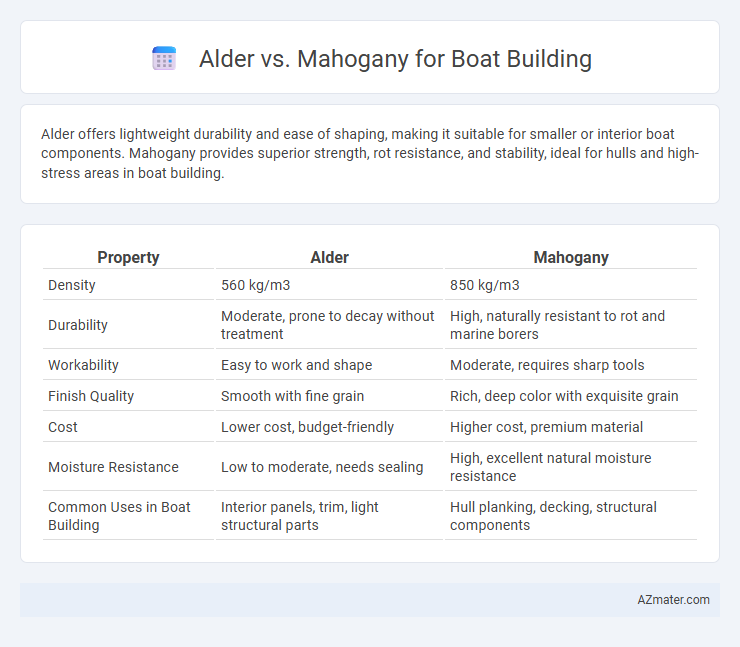Alder offers lightweight durability and ease of shaping, making it suitable for smaller or interior boat components. Mahogany provides superior strength, rot resistance, and stability, ideal for hulls and high-stress areas in boat building.
Table of Comparison
| Property | Alder | Mahogany |
|---|---|---|
| Density | 560 kg/m3 | 850 kg/m3 |
| Durability | Moderate, prone to decay without treatment | High, naturally resistant to rot and marine borers |
| Workability | Easy to work and shape | Moderate, requires sharp tools |
| Finish Quality | Smooth with fine grain | Rich, deep color with exquisite grain |
| Cost | Lower cost, budget-friendly | Higher cost, premium material |
| Moisture Resistance | Low to moderate, needs sealing | High, excellent natural moisture resistance |
| Common Uses in Boat Building | Interior panels, trim, light structural parts | Hull planking, decking, structural components |
Introduction to Alder and Mahogany in Boat Building
Alder and mahogany are popular hardwoods used in boat building due to their durability and workability. Alder is valued for its fine grain, resistance to warping, and affordability, making it suitable for interior components and smaller boats. Mahogany offers exceptional rot resistance, stability in wet conditions, and a rich reddish color, making it a preferred choice for hulls and high-end marine applications.
Wood Properties: Strength and Durability
Alder wood offers moderate strength and good workability but lacks the natural resistance to rot and moisture essential for marine environments. Mahogany exhibits superior durability and high strength, with excellent resistance to decay, making it a preferred choice for boat building. Its dense grain structure and stability under varying weather conditions contribute to longer-lasting, structurally sound vessels.
Resistance to Water and Rot
Alder wood, known for its moderate water resistance, absorbs moisture more easily than mahogany, making it less durable in consistently wet environments. Mahogany features exceptional natural resistance to water and rot due to its dense grain and natural oils, which enhance longevity in marine conditions. This superior durability makes mahogany a preferred choice for boat building where exposure to water and rot is a significant concern.
Weight and Buoyancy Comparison
Alder wood is lighter than mahogany, weighing approximately 28-33 lbs per cubic foot compared to mahogany's 40-45 lbs per cubic foot, directly influencing overall boat weight and ease of handling. The lower density of alder enhances buoyancy, making vessels constructed from it slightly more buoyant and energy-efficient in water. Mahogany's higher density contributes to increased durability and resistance to impact but results in reduced buoyancy and greater draft.
Workability and Finishing Qualities
Alder wood offers excellent workability due to its fine, even texture and moderate hardness, allowing for precise cutting, shaping, and sanding in boat building. Mahogany, prized for its natural oils and stable grain, provides superior finishing qualities with a smooth, rich surface that accepts stains and varnishes exceptionally well, enhancing durability in marine environments. Both woods are favored in boat construction, but mahogany's finishing qualities often make it the preferred choice for visible, high-end applications.
Cost and Availability of Materials
Alder wood is generally more affordable and widely available than mahogany, making it a cost-effective choice for boat building projects. Mahogany offers superior durability and resistance to rot but comes at a higher price due to its slower growth rate and limited supply. Availability of alder is higher in North America, while mahogany is often sourced from tropical regions, affecting both cost and shipping times.
Environmental Impact and Sustainability
Alder wood is often favored in boat building for its rapid growth and renewable characteristics, making it a more sustainable choice compared to mahogany. Mahogany, while prized for its durability and aesthetic appeal, is sourced from slow-growing tropical forests, raising significant environmental concerns related to deforestation and habitat loss. Selecting alder supports eco-friendly practices by reducing carbon footprints and promoting responsible forest management in marine construction.
Traditional vs. Modern Use in Boat Construction
Alder wood, prized historically for its lightweight and ease of shaping, has been a traditional choice in boat construction, especially for smaller vessels and interior components. Mahogany, with its superior durability, resistance to rot, and rich reddish hue, dominates modern boat building, favored in luxury yachts and high-performance boats for its strength and aesthetic value. Both woods reflect evolving craftsmanship, where alder aligns with classic techniques, while mahogany supports advanced, long-lasting marine applications.
Maintenance Requirements Over Time
Alder wood requires more frequent maintenance due to its softer nature and higher susceptibility to denting and water absorption, necessitating regular sealing and varnishing to prevent rot and swelling. Mahogany is highly valued for boat building because of its natural resistance to decay, insects, and moisture, making it a low-maintenance option that maintains structural integrity over time. The superior durability of mahogany reduces the need for frequent upkeep, ultimately lowering long-term maintenance costs compared to alder.
Final Verdict: Choosing Alder or Mahogany for Your Boat
Alder offers lightweight durability and easy workability, making it ideal for smaller boats or those requiring frequent maintenance. Mahogany stands out with superior rot resistance and a classic aesthetic, preferred for high-end, long-lasting vessels. The final choice depends on balancing budget, boat size, and desired longevity, where alder suits cost-effective builds and mahogany meets premium quality demands.

Infographic: Alder vs Mahogany for Boat Building
 azmater.com
azmater.com